Iron Age Museum of Tabriz with Relics from 3500 Years Ago
The Iron Age Museum of Tabriz is renowned as Iran’s first open-air museum. This museum offers a distinctive experience compared to any you've visited before, showcasing ancient skeletons buried using unique methods.
The museum is situated behind the Blue Mosque in Tabriz, on Imam Street. Registered as a national heritage site on October 25, 2000, it represents artifacts from the second and first millennia BCE.
Established in 2006, the Iron Age Museum became Iran’s first open-air museum, following its discovery of 38 burial sites in 1997. Here, you can see infant burials in simple graves and adolescent remains in square structures with pottery. Most remains are from young individuals, with children buried alongside their toys and adults with their weapons and jewelry.
The burial practices reflect Mithraic beliefs, with stones arranged around the bodies symbolizing the womb and the bodies buried in fetal or crouched positions. Join us to discover why this museum is a must-see and how its unique exhibits continue to intrigue visitors.
Why Visit the Iron Age Museum of Tabriz?
- First Open-Air Museum: It is recognized as Iran's first open-air museum, offering a unique experience.
- Ancient Artifacts: The museum features relics dating back over 3,500 years, showcasing a long history.
- Global Importance: The artifacts possess significant global value due to their age and historical relevance.
- Cultural Insight: It provides an insightful look into ancient civilizations and their culture.
History of the Iron Age Museum of Tabriz
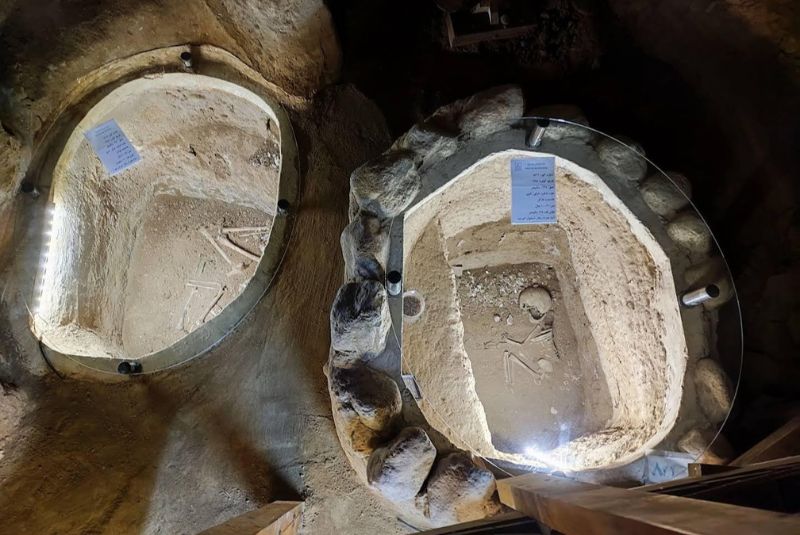
The Iron Age Museum of Tabriz, an exceptional historical site, was discovered in 1997 during excavation work near the Blue Mosque of Tabriz. Over the next three years, archaeologists unearthed a wealth of artifacts from the site, including decorative items, pottery, and mass graves.
Initially, researchers identified the artifacts as belonging to various periods, including the Safavid, Qajar, Timurid, Zandieh, and Ilkhanid eras. However, most of the findings date back to the Iron Age, approximately 1000 BCE, which is why the museum is named after this era.

By 2006, the site was officially transformed into an archaeological museum, showcasing the extensive history captured in these ancient remains. The museum reveals fascinating insights into Iron Age burial practices, with many of the deceased being interred with personal belongings such as toys, jewelry, and weaponry.
These grave goods not only reflect the individuals’ social status but also indicate the prevalence of Mithraism, as many were buried in a fetal position, symbolizing the womb.
Why is It Called the Iron Age Museum?
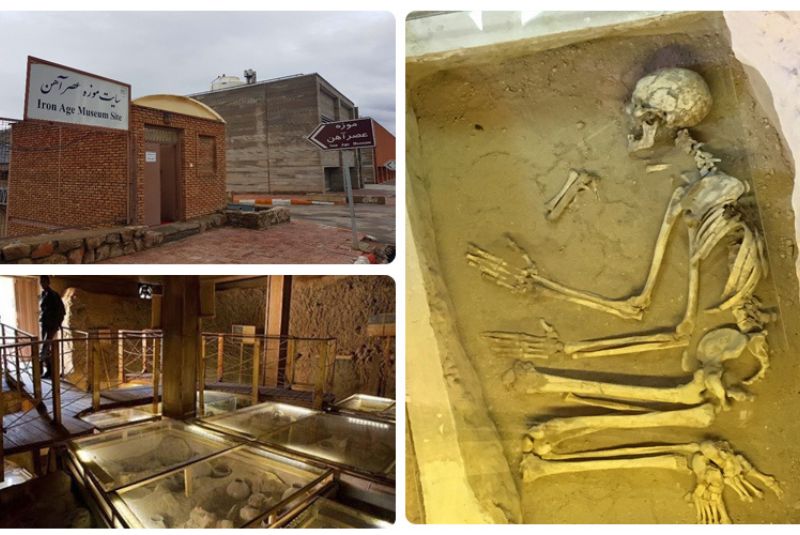
The Iron Age Museum of Tabriz is named for the era it represents, known as the Iron Age, which spanned from approximately 1000 to 2000 BCE. During this period, people extensively used iron for making tools and weapons, marking a significant advancement in technology and culture.
In Western Asia, the Iron Age concluded with the rise of the Achaemenid Empire. This epoch is considered a pivotal chapter in human history, bridging prehistoric times with the dawn of recorded history. The museum’s focus on artifacts from this transformative period justifies its name.
Architecture of the Iron Age Museum of Tabriz

The Iron Age Museum of Tabriz is uniquely designed to blend with its archaeological setting. The building has a mound-like shape, which creates varying levels for the graves and results in different burial depths.
Visitors enter through a small door leading into a building with wooden stairs and simple mud-brick walls. Descending the stairs takes you to the ticket counter and then into the historic site of the museum.
Located eight meters below street level and above groundwater in a humid area, the museum requires careful management of moisture. Ventilation systems and fans embedded in the walls and ceiling help control humidity.

Since the site has remained unchanged since its discovery, it retains a cave-like atmosphere, which limits its capacity to 15 visitors at a time. Narrow wooden bridges span the graves, allowing visitors to observe without damaging the artifacts.
The Tabriz Iron Age Museum covers approximately three hectares and is divided into two main sections connected by bridges. The first section displays individual skeletons and graves, while the second features artifacts and ancient objects.
Different Parts of the Iron Age Museum
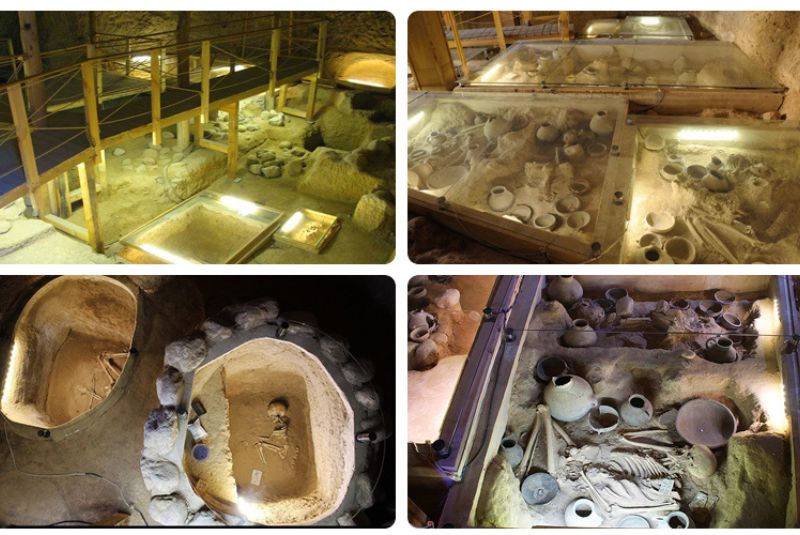
Entrance and Initial Impressions
Entering the museum involves descending about twenty steps to reach the small entrance where the ticket booth is located. Inside, the museum’s layout maintains its archaeological integrity, offering a unique glimpse into ancient burial practices.
Grave and Skeleton Exhibits Section
The first section of the museum showcases 38 ancient graves, predominantly from the first millennium BC. Most of the skeletons are buried in a fetal position, reflecting the belief that humans should be interred in the same position as in the womb.
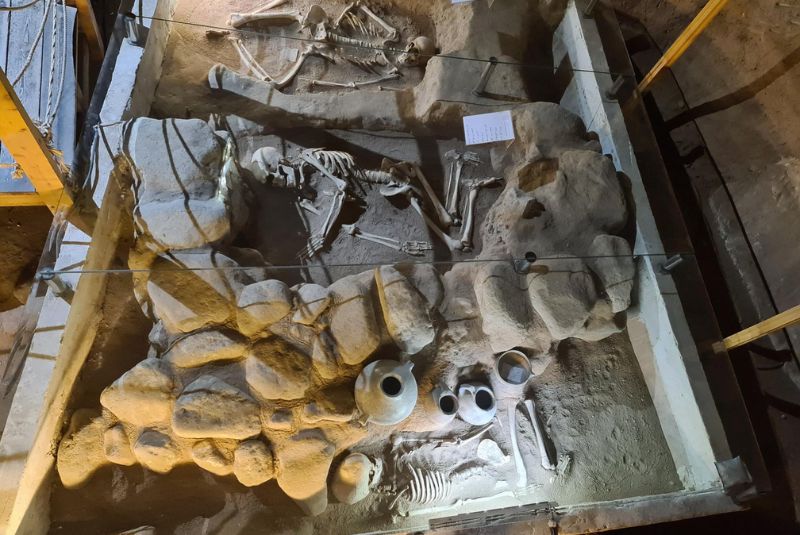
Only one skeleton is laid out flat, possibly due to the conditions of its interment. Artifacts found with the dead include toys for children, jewelry for women, and weapons for men, highlighting the customs and social stratification of the time.
Artifacts and Decorative Items Section
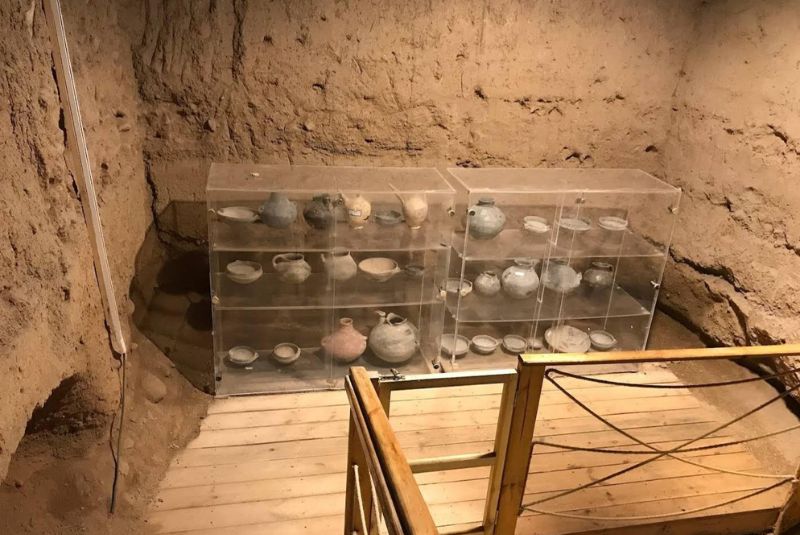
The second section of the museum displays decorative and utilitarian artifacts, including pottery, plates, bowls, glasses, and weapons. The items are housed in glass cases for preservation and are lit with a combination of ground and wall lighting to enhance visibility in the dark, cave-like environment.
Unique Burial Practices
The Iron Age graves show secondary burial practices, where remains from other locations were brought to this sacred site. This indicates the site's importance and its role as a significant burial ground. Men were buried on their right side and women on their left, with the bodies oriented north.
Amenities
The museum is equipped with essential facilities for visitors, including parking, restrooms, and a restaurant. Guided tours are available to enhance the experience and provide detailed insights into the exhibits.
Artifacts of the Iron Age Museum of Tabriz
- Skeletons and Graves: Excavations revealed 38 graves, primarily from the Iron Age, with bodies buried in a fetal position. Graves vary in size and shape, with infant graves being simple and small, and adolescent graves arranged in square structures.
- Pottery and Artifacts: Each grave includes artifacts such as pottery. For adolescents, graves contain two pottery vessels. These artifacts provide insights into the age, gender, and social status of the individuals buried.
- Burial Goods: Children were buried with toys, women with jewelry, and men with weaponry. The presence of these items reflects their social status and beliefs.
- Religious and Social Significance: Some graves include food vessels and other objects, indicating the religious practice of Mithraism. Graves with more artifacts suggest wealthier individuals.
Iran's Iron Age Museum Location
The museum is located behind the Blue Mosque in Tabriz, on Imam Street.
Opening Hours
Daily from 09:00 AM to 02:00 PM.
Ticket Prices
For Iranian citizens: 4,000 Toman
For foreign visitors: 30,000 Toman
How to Get There
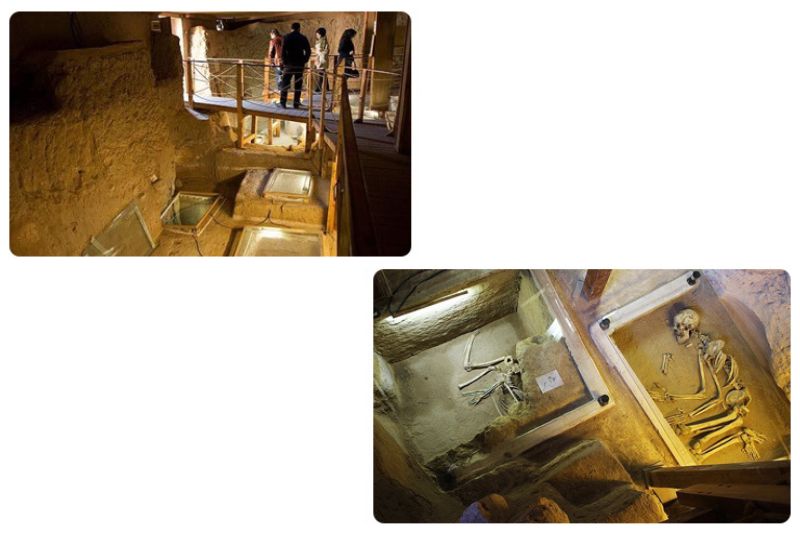
You can reach the Iron Age Museum using rapid buses, personal vehicles, or the metro.
Route 1
From Sa'at Square, enter Imam Khomeini Street and continue towards the Blue Mosque. Enter the basement area of the bazaar, and from the back exit, you will reach Rouhani Street, which is a short walk up to the museum.
Route 2
Head to Khaghani Street and turn left onto Rouhani Street. The museum will be visible just beyond Mollah Reza Mosque and the Blue Bazaar.
Nearest Route
The closest access is from the Blue Mosque. Enter the Blue Bazaar, go down the stairs to the parking area, exit through the vehicle entrance, and the Iron Age Museum will be the first door on the right.
Nearby Tourist Attractions
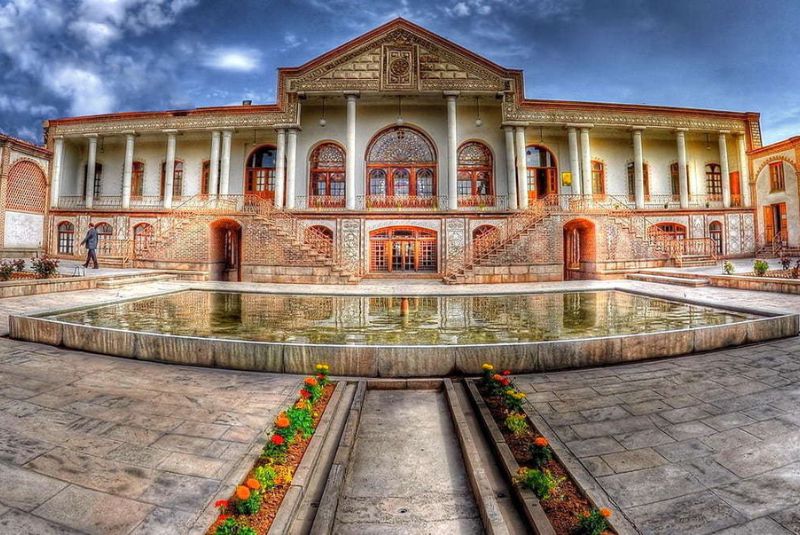
- Blue Mosque (Masjid-e Kabud): Located just 550 meters from the Iron Age Museum of Tabriz, the Blue Mosque is a must-see for its stunning turquoise tilework and historical significance. This 15th-century mosque, known for its intricate design and grandeur, offers a glimpse into the architectural brilliance of the era.
- Azerbaijan Museum: Only 600 meters away, the Azerbaijan Museum features a rich collection of artifacts from Iran's historical and cultural heritage. It provides an excellent overview of regional history and art.
- Tarbiat Pedestrian Bridge: Situated 2 kilometers from the museum, this pedestrian bridge offers scenic views and connects various parts of the city, making it a pleasant spot for a leisurely walk.
- Noubar Bath Museum: Located 2.2 kilometers away, this museum is housed in an old bathhouse and showcases traditional Persian bath culture and architecture.
- Qajar Museum: About 2.9 kilometers from the Iron Age Museum, the Qajar Museum is set in a historical mansion and presents artifacts and exhibits from the Qajar dynasty, highlighting the opulence of the era.
Nearby Hotels
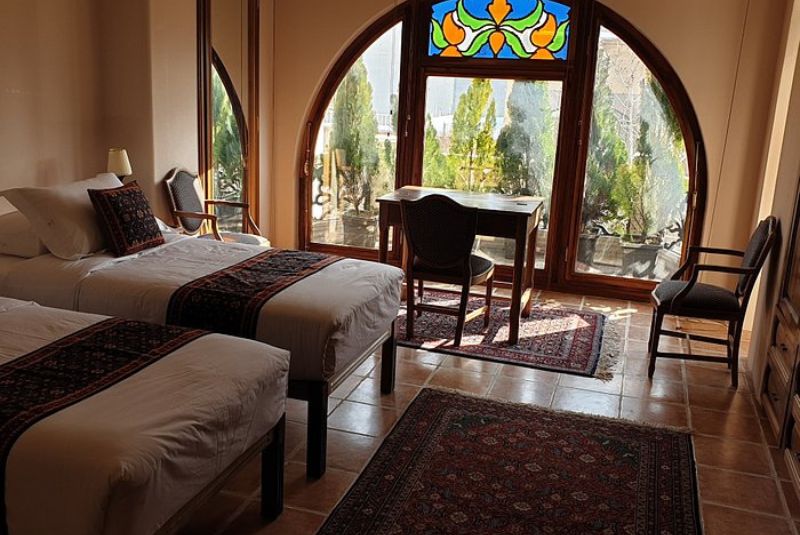
- Caspian Hotel: Just 1.4 kilometers from the museum, Caspian Hotel offers comfortable accommodations with modern amenities, making it a convenient choice for visitors.
- Behbood Hotel: Located 1.5 kilometers away, Behbood Hotel provides a welcoming stay with excellent service and a range of facilities.
- Esteglal Hotel: 2.2 kilometers from the museum, Esteglal Hotel features well-appointed rooms and a good location for exploring the city.
- Tabriz Hotel: At 2.5 kilometers from the Iron Age Museum, Tabriz Hotel is a historic establishment offering both comfort and convenience.
- Ahrab Hotel: 3.5 kilometers away, Ahrab Hotel is known for its hospitality and comfortable accommodations.
- Gostaresh Hotel: Situated 4.3 kilometers from the museum, Gostaresh Hotel provides a range of amenities and services for a pleasant stay.
Nearby Restaurants
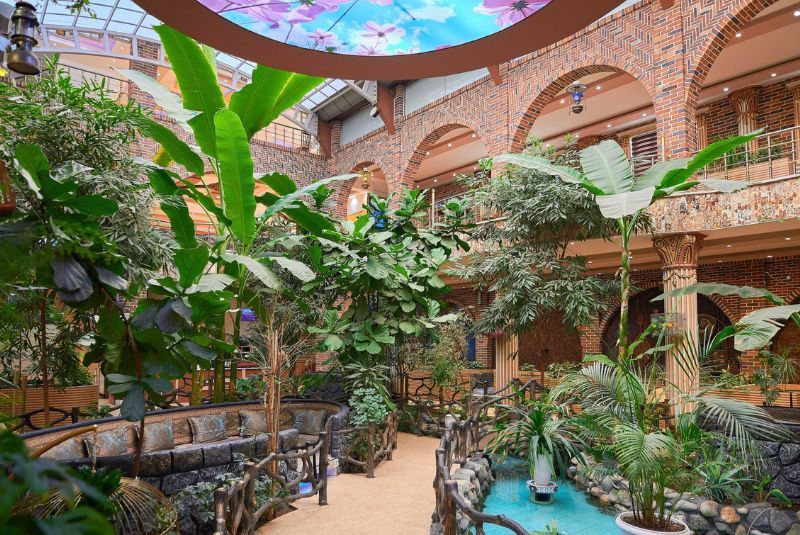
- Naranjestan Restaurant: Only 400 meters from the museum, Naranjestan offers a variety of traditional Iranian dishes in a cozy setting.
- Amir Ashkadeh: Located 600 meters away, this restaurant specializes in hearty Persian stews and offers a warm dining experience.
- Azadi Kebab: 1.5 kilometers from the museum, Azadi Kebab is renowned for its delicious kebabs and is a popular spot for meat lovers.
- Pak Khushmazeh Restaurant: 1.7 kilometers away, Pak Khushmazeh provides a range of tasty dishes and a comfortable dining environment.
- Aslani Kebab: 2 kilometers from the museum, Aslani Kebab is known for its authentic flavors and quality grilled meats.
- Shahzadeh Restaurant: 2.8 kilometers away, Shahzadeh offers a delightful menu with a focus on traditional Persian cuisine and a charming atmosphere.
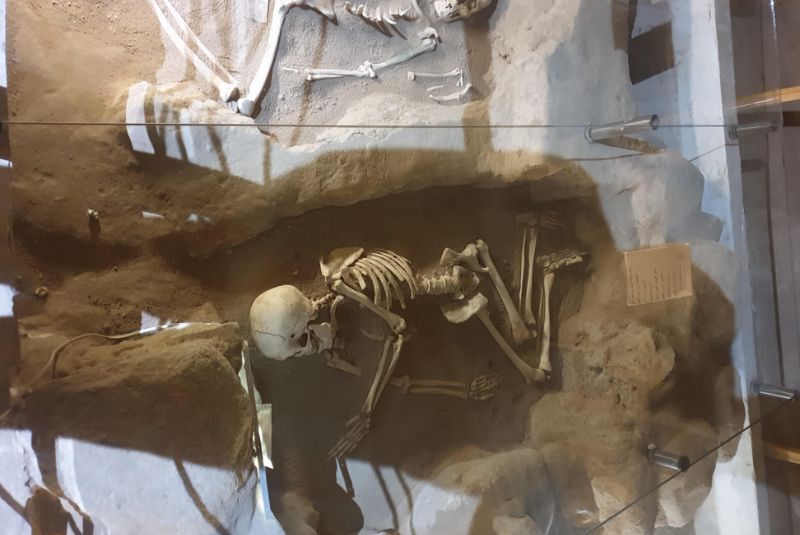
Bottom Line
The Iron Age Museum of Tabriz is Iran’s first open-air museum, offering a unique glimpse into ancient burial practices. Located behind the Blue Mosque on Imam Street, this museum showcases artifacts from the first and second millennia BCE, including 38 burial sites discovered in 1997.
Established in 2006, the museum features infant and adolescent graves, with most remains belonging to young individuals buried with their toys, jewelry, or weapons.
The burial practices reflect Mithraic beliefs, with stones arranged around bodies symbolizing the womb. The museum's design, resembling a cave, limits visitor capacity but provides a fascinating, immersive experience into the Iron Age era.
Share your story!
Comment below and let us know about your Experience.
Your story inspires others!


Comment
Leave a Comment